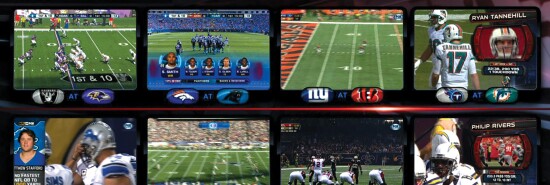
The case against RedZone
Graham Hillard
To say that people watch professional football differently these days is like saying that John Madden had a better post-playing career than O.J. Simpson. In my 1980s childhood, one had to monitor televised games like a champion birdwatcher, lest one miss the occasional flitting by of the score. Until 1994, when NFL Sunday Ticket began bringing out-of-market games into viewers’ homes, one saw one’s regional team on game day, along with whatever national contests the networks deigned to air — and one liked it.
The idea of choice in those days was limited strictly to one’s accessories: Barcalounger or sofa, Bud Light or Bud. Today, however, the home audience is king. Want a traditional, single-game telecast, albeit with enough “score bugs” (i.e., digital on-screen graphics) to launch a plague? CBS and Fox are happy to help. Want a seven-hour, commercial-free, highlight-reel apocalypse? You just might be in the market for NFL RedZone.
MEDIAN HOUSEHOLD INCOME FELL IN 2022, ADJUSTED FOR INFLATION, CENSUS BUREAU SAYS
The NFL RedZone channel broadcasts live action from 1-8 p.m. Eastern time every Sunday of the NFL’s regular season. Tune in during the other 161 hours of an autumn week, and one is treated to the NFL equivalent of dead air: a “Come Back Soon” message accompanied by a vaguely militaristic score. Watch on the Lord’s Day, and one is sucked into a viewing morass from which escape is unlikely, if not outright impossible.
Like a TikTok session but without the algorithmic villainy, an afternoon in front of NFL RedZone presents no obvious exit strategy. The channel’s editing, superbly handled from Inglewood, California, is as bang-bang as a double-barreled shotgun and zips the viewer painlessly from city to city, with almost nothing in the way of huddles and timeouts. Though single- or double-game coverage is the norm, NFL Redzone can show as many as eight games at once — an eventuality known, not without some reverence, as the “Octo-box.”
The channel’s premise is simple: If half a dozen matchups are taking place simultaneously, surely one of them is exciting at any given moment. In theory, this occurs when a team’s offense reaches the “red zone,” or the last 20 yards before a touchdown. In practice, the station broadcasts action from anywhere on the field so long as the game situation is enticing. If Miami speedster Tyreek Hill bursts 90 yards for a touchdown, NFL RedZone will capture it, either live or 10 seconds later. If a goal-line stand is underway, the RedZone viewer will be there.
Whom all of this is for will be easy enough to guess for readers who have followed the rise of fantasy sports, the casino-ization of American athletics, and the shortening of the national attention span. Regarding the first of these, it is estimated that some 29 million people played fantasy football last season, thus giving themselves a vested interest in every game, not just the hometown team. Gambling, too, has soared in recent years. According to a just-released survey from the American Gaming Association, upward of 73 million people plan to wager on the NFL this season, a marked increase from last fall’s number.
One way to think about NFL RedZone is as an economically inevitable response to the commoditization of football components, not just games. As most readers will be aware, fantasy football grants no points for team wins and losses, rewarding instead the statistical excellence of individual players. In-game or “live” betting works similarly, rendering overall point spreads temporarily moot as sharps chase the next touchdown, turnover, or tackle. To watch a single-game broadcast, to care solely about which team wins, feels decidedly old-fashioned in 2023, like rocking out to a Walkman. People still do it, as the networks’ stratospheric football ratings make clear. But one does get the sense that NFL consumption habits are moving in a different direction.
CLICK HERE TO READ MORE FROM THE WASHINGTON EXAMINER
Or perhaps gambling and fantasy are relatively minor contributors to NFL RedZone’s success. Mightn’t a better explanation be the literal inability of some people to commit to a single three-hour event featuring countless commercials, play stoppages, and timeouts? It is often speculated that football’s popularity is due in part to the game’s design: discrete plays occurring at regular intervals, granting the audience time to anticipate and reflect. But what if we, as a people, are simply outgrowing that predilection? Surely our evolution (or devolution) will lead us to something very much like the RedZone channel. Need I even say, at this point, that quiet contemplation is not part of the viewing experience?
Rather, an afternoon in front of NFL RedZone is rather electric, if I’m being completely honest. Electric, that is, until it turns one into a football zombie. For me, this typically happens around 6 p.m., when the late games begin coming back from halftime. A handy rule of thumb: If one is trying to decide whether a trip to the bathroom is “worth it,” it’s probably time to turn off the television and go for a walk.
Graham Hillard is a Washington Examiner magazine contributing writer and editor at the James G. Martin Center for Academic Renewal.
